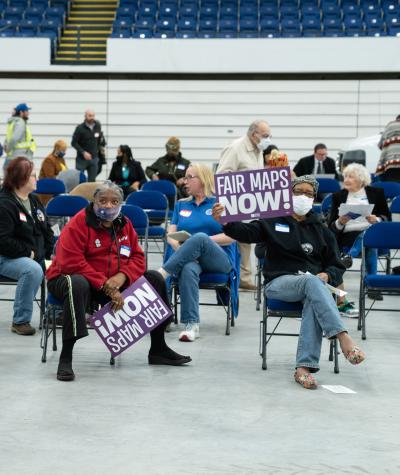Every 10 years, the United States experiences a new cycle of “redistricting.” Responding to data from the census, state legislators or other map-drawers revise the district lines for the U.S. House of Representatives, state legislatures and other representative bodies, in order to equalize the districts’ population.
In that process, it is possible to manipulate the lines to create a significant partisan skew — i.e., to create a partisan “gerrymander” — but it is also possible to draft district lines that allow fair representation of the voting population in each state.
With the current redistricting cycle moving toward a conclusion, it is a good time to assess how the fight for fair maps and against gerrymandering fared.
To be sure, while a lot has happened in the current redistricting cycle so far, it’s important to remember there is still work to be done. But so far, we’ve seen wins that have brought us closer to the ideal of fair maps, and instances where states have fallen short in guaranteeing fair maps for their voters.
Independent redistricting commissions have helped create nonpartisan maps in some states, though work remains.
Although state legislatures still control redistricting in most states, there has been a movement in recent years toward establishing nonpartisan institutions and processes — like independent redistricting commissions (IRC) — to try to remove politics from map-drawing, so that the resulting maps don’t skew the outcomes of elections.
This cycle has seen a mix of successes and failures on that front.
For example, in Arizona, there was a widespread perception that the Republicans had gamed the system to capture control of that state’s IRC, and the new congressional map was indeed somewhat more favorable to the Republicans, although it still scores relatively well on measures of partisan fairness.
In Ohio, which has a complicated multistep process involving both legislators and a backup commission, combined with a ban on partisan gerrymandering, there was open defiance of the Ohio Supreme Court and a resulting congressional map that is highly skewed in favor of the Republicans.
However, other states exhibited a greater commitment to partisan fairness. For example, California’s system continued to function well, and Michigan’s new IRC, which Campaign Legal Center (CLC) has repeatedly defended in court, produced fair maps as well.
Virginia also was trying out a new commission system. That commission ultimately deadlocked, failing to produce district maps. But that just pushed the matter to the Virginia Supreme Court, which saved the day by appointing two special masters, one Republican and one Democrat, and instructing them to come back with maps they both supported (which they did).
IRCs can help prevent gerrymandering and, with strong protections and a membership made up of citizens not politicians, they can succeed. This cycle showed that.
Fair courts are essential for fair maps.
When it comes to maps drawn by legislatures controlled by one party or the other, some form of muscular judicial review is an essential check. But, at the federal level, the U.S. Supreme Court has seriously undermined protections against racial discrimination in redistricting.
First, the Court invalidated the Section 5 preclearance requirements of the Voting Rights Act in 2013, meaning that potentially racially discriminatory plans could not be stopped before they went into effect. Second, the Court held that federal courts may not even consider claims that district maps violate the Constitution because of their partisan skew.
State courts applying state law, on the other hand, have stepped up for fair maps in North Carolina, Pennsylvania, New York and Maryland. But they fell short in Kansas and Wisconsin.
Gerrymandering remains a problem.
Even though fair maps were enacted in some states this cycle, gerrymandering remains far too commonplace.
CLC’s PlanScore library has been cataloguing proposed and enacted maps from across the country. The PlanScore library shows us that in both “blue” states, like Illinois, and in “red” states, like Florida, Texas and South Carolina, gerrymandering is still happening and still denying voters the equal opportunity to make their voices heard.
Take, for example, CLC’s lawsuit in Utah. State legislators there defied the will of voters, ignoring neutral maps drawn by a nonpartisan commission and producing their own gerrymandered map that “cracks” Salt Lake County into four different districts to lock in their power for another decade.
We still have work to do to make the promise of fair maps a reality in all 50 states.
The final story of this redistricting cycle remains to be told.
The battle for fair maps is still ongoing in the U.S. Supreme Court. We are facing two looming threats that would have serious consequences for our democracy.
First, in an Alabama case, the Court may seek to limit or eradicate the remaining protections of the Voting Rights Act — Section 2’s nationwide ban on district maps that dilute minority voting strength.
Second, in a North Carolina case, there is a risk that the Court will apply an aggressive form of the Independent State Legislature doctrine to bar state courts from limiting gerrymandering of congressional maps.
Bottom line: The story of this cycle is unfinished, and we have a choice between a democracy that is inclusive, transparent and equitable or one that silences certain voices for political gain. Voters should choose their leaders, not the other way around.

